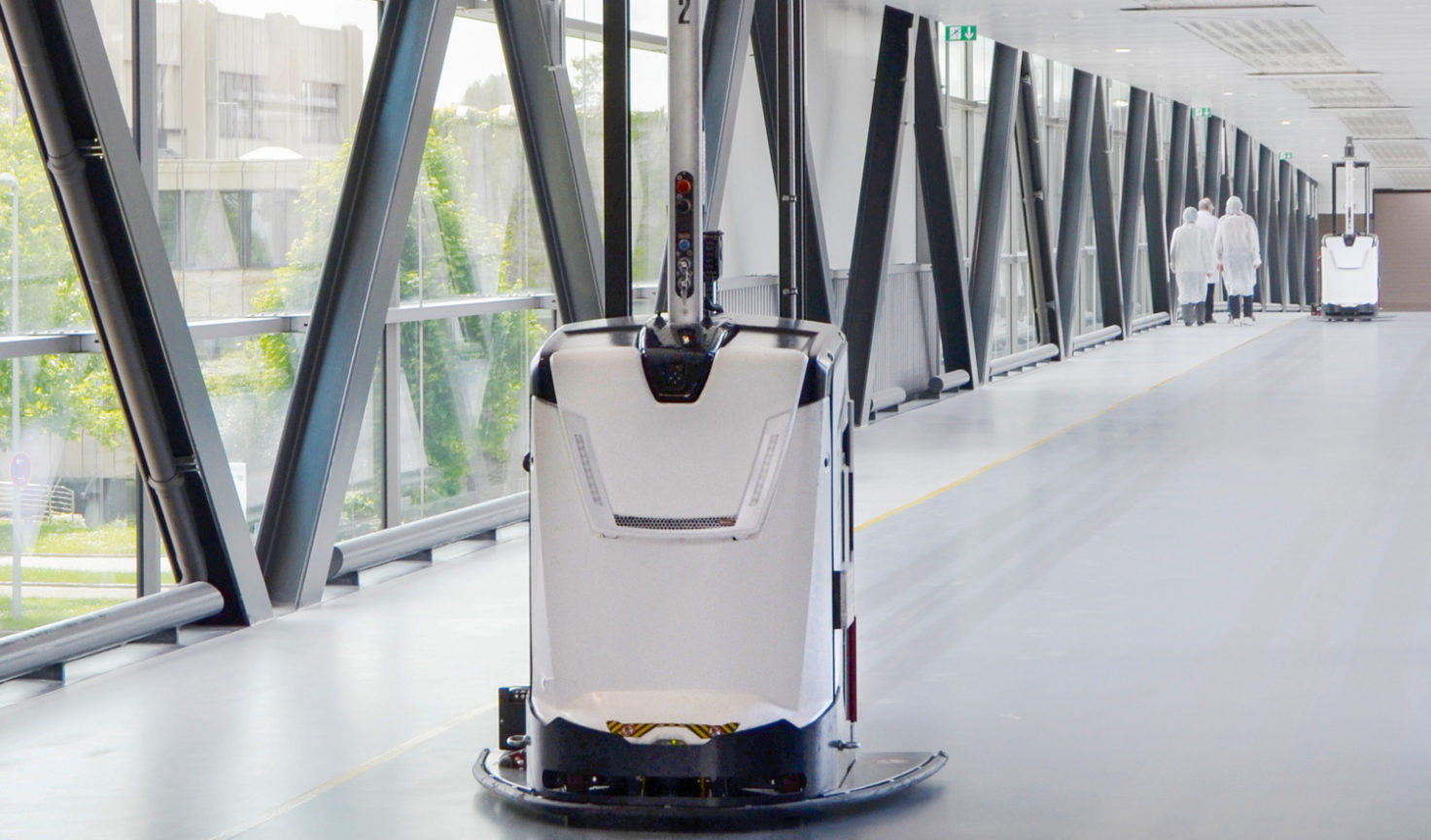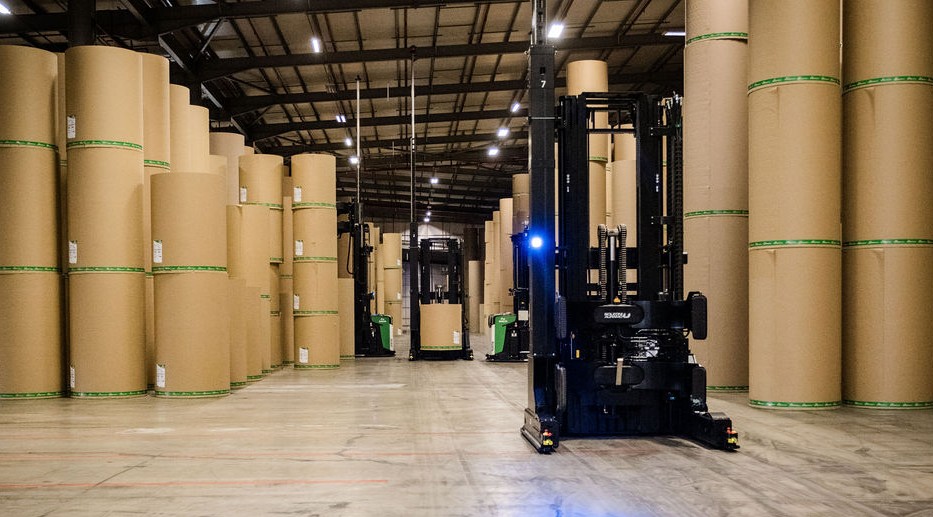SEEBERGER: High transport volumes and fast AGV payback time at the dried fruit and nut factory
Seeberger GmbH, Germany’s leading producer of dried fruit and nuts, uses Rocla’s AGVs at its production plant in Ulm, where it employs more than 500 staff. The family company has grown rapidly over the past few decades and is now Germany’s leading dry fruit and nut brand. Seeberger is also renowned for its high-quality coffee.

Return on an investment in an automated transport solution was an attractive solution for Seeberger due to the high transport volumes with which it works. Accurately synchronized in-feeding of raw materials to the packing machines and as little as possible intervention in the existing infrastructure were significant prerequisites for the company. The automated guided vehicle (AGV) stood out as the best solution in this regard. Five Rocla AGVs transport the raw materials from the warehouse to the Seeberger GmbH production facility.
The fruit and nut pallets are relatively lightweight, and this is why Seeberger chose the ATX12 as its AGV model in 2012. The ATX12 is an AGV designed specifically for pallet transport, capable of lifting loads of up to 1,250 kg to a height of 1,800 mm. The structure of this vehicle is modular and particularly compact, making it especially suitable for use in areas with limited space.
Safe and efficient
Project manager Marc Eberhardt is pleased with Rocla’s Automated Guided Vehicle (AGV) system. He stresses the reliability and efficiency of the system.
“The AGV and our automatic high bay storage facility are controlled by our production management system (PMS). This allows optimum interaction of our various systems. We achieve maximum utilization of the AGV systems transport capacity thanks to minimal waiting times at the warehouse and accurately synchronized delivery of the raw materials to the packing machines. The high level of automation ensures that the right goods are in the right place at the right time and in the right quantities. Moreover, we maintain a constant accurate overview of our current flow of goods and stock levels,” Project Engineer Marc Eberhardt says.
Marc Eberhardt is one of Seeberger’s four project engineers. He has been working for the company for almost four years and was involved in the introduction of the AGV system from the outset. The system was programmed and supplied according to Eberhardt’s and his colleagues’ specifications. Programming was optimized when actual production conditions were taken into account during commissioning. Close cooperation between Seeberger and Rocla were the key to a successful project.
“Before commissioning, we implemented a thorough planning phase followed by various simulations. Only then were the machines deployed. We invested sufficient time in each phase in order to achieve the best possible results. The system has been running very stably since the end of the optimization phase. No major corrections were necessary,” Marc Eberhardt emphasizes with satisfaction.
Admittedly, the staff were reluctant to work with the new driverless transport vehicles initially. However, they soon abandoned their reservations when it became clear how reliably, safely and efficiently the AGV works. Since the system was deployed, there have been no accidents or any damage to property.
Reliable workers
The AGVs always travel independently to the charging station to charge the batteries if no transport jobs are pending or if the remaining battery capacity so demands. Under normal conditions, the battery has enough charge for one shift. The battery-operated vehicles are praised highly for their quiet operation and low emissions. Traditional forklift trucks are louder and more susceptible to damage, as they are operated by humans.
The driverless transport vehicles find their way around by means of a laser navigation system. A navigation laser is installed in the lift mast which the vehicle uses to find its way around the operational area by means of triangulation. The operator interface for the AGV control system can be used to identify the precise position of all vehicles in real time. System communication takes place via WLAN, which allows the vehicles to maintain constant contact with the control system, reporting their status and position and receiving their transport jobs accordingly. Transport jobs are assigned to the most suitable vehicle for the job, taking into account the routing and possible priorities.
The vehicles identify their surroundings by means of sensors. Obstacles can therefore be detected quickly, allowing the vehicle to brake accordingly depending on the situation, or instigating an emergency stop if necessary. As soon as the obstacle has been removed, the vehicle automatically moves off again. The AGVs are virtually silent. The vehicles draw attention to themselves by means of visual and acoustic warning signals.
The speed of the vehicles is relatively low so as to ensure a high level of protection for personnel. A high level of efficiency is maintained through the continuous operation of the system. Eberhardt estimates that the system will pay for itself in less than three years.
Special ramp
The Seeberger production plant has a ramp with a gradient of 9%. One of the project objectives was to integrate this ramp into the vehicle routes without adversely affecting the overall performance of the AGV. To do this, additional safety measures had to be implemented to ensure redundant detection of the ramp and so limit the speed restrictions to this area. As there are no standard solutions for such applications, Rocla cooperated closely with Seeberger and the relevant professional association to develop a special solution for this application.
Independent detection of the ramp was achieved through additional installations on the ramp and vehicles. A magnetic switch on the vehicle is activated and deactivated by magnetic strips in the floor. A separate sensor also detects the angle of tilt of the vehicle caused by the ramp. This ensures redundant detection of the ramp and the system can reduce the speed for this area flawlessly and within safety regulations.
The floor of the ramp is also provided with a special coating in order to increase friction and so ensure improved braking performance.


